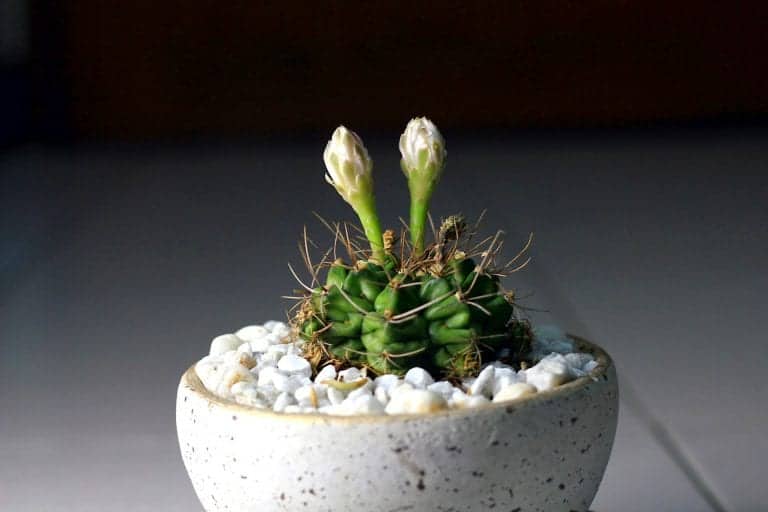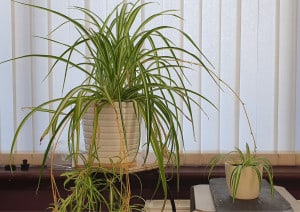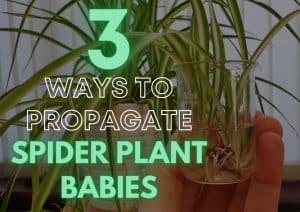How Do Indoor Plants Get Pollinated?
-
Chris Dosser
- November 12, 2021
If you buy something using the retail links in our articles, sometimes we earn a small affiliate commission. This does not impact the products we recommend.
Pollination refers to sexual propagation where flowers and then seeds are produced by an adult plant.
Most plants kept indoors as houseplants will never quite find the right set of conditions to flower and set seed as they would in their natural habitat, in which case they will continue to propagate through asexual means such as cuttings of roots, leaves or stems.
Indoor plants that do reach their flowering stage can be cross-pollinated through biotic factors (pollinator insects & human intervention) or abiotic factors (air circulating around the room).
Self-pollination, where the close proximity of male and female flowers to one another enables fertilization is also a way in which some houseplants can be fertilized.
If waiting for plants to bloom sounds like a long slog and you’re itching to produce more plants from your existing greenery, why not apply some of the propagation tips listed in our guide covering how to propagate Swiss Cheese plants.

Pollination of houseplants by biotic means (+ DIY tips)
Cross-pollination is when a plant requires fertilization from another of the same species to produce seeds or fruits.
Cross-pollination is made possible indoors by a vector that transports the pollen from the male flower to the female flower to facilitate fertilization.
Cross pollination of indoor plants by insect
Cross-pollination by insects is the most recognized form of pollination – and this is no different for indoor plants.
Obviously insects aren’t as commonly found in our homes but even so, ants, wasps, flies and moths are all visitors capable of carrying pollen from one flower to the next.
Artificial cross pollinating your indoor plants
Now, it’s unlikely you have a beehive inside your home, and moths are not going to RSVP to an invite…so how do indoor plants get cross-pollinated?
If you want to cross-pollinate plants indoors in the absence of insects, you are going to have to facilitate the fertilization process.
This isn’t too complicated a process and there are a couple methods that experienced gardeners use to cross-pollinate their houseplants.
- Using a paintbrush or other small tool to transfer the pollen
- Removing the male flower from the plant and using it as a direct source of pollen
Identify male vs female flowers
Before attempting cross-pollination, you must be able to tell the difference between male and female flowers. The simplest way to do so is to hop online and pull up an image search of the exact plant you are trying to pollinate.
You may also look carefully at the internal structure of the flower. Flowers with a more complex internal structure and a bulbous base are female whilst the male flowers have a single tall structure in the center of the flower.
Telling them apart is critical as male flowers tend to bloom slightly before female flowers, so for some species pollen collecting may be required.
Use a paintbrush to make sure your indoor plants get pollinated
To cross-pollinate plants using a paintbrush, gently brush the flower’s anther to transfer pollen onto your brush. Then gently brush the stigma to transfer the pollen and fertilize the plant.
A small paintbrush is perfect for cross-pollination, but you can also use any small tool that will gently transfer the pollen from flower to flower.
This method of cross-pollination is a little more fragile and time consuming, but it protects the integrity of the plant.
An example of how to use a paintbrush (admittedly on a more industrial scale) to hand pollinate is on show in Anj Creative Solution’s tutorial about Philodendron.
Use a male flower to cross-pollinate
To cross-pollinate using the male flower, you need to take the male flower off your plant. Pull the petals back from the flower then rub the anther of the removed male flower onto the stigma of the female flower.
This method of cross-pollination requires you to remove the male flower from the plant which isn’t ideal, but it is an effective fertilization technique.
Cross-pollination of indoor plants by abiotic factors
Cross-pollination by the wind is another method by which indoor plants get fertilized.
Plants that are wind-fertilized are usually plants that do not have traditional male and female flowers because they do not need to attract pollinating vectors like bees.
When a wind-fertilized plant grows, it produces a lot of light pollen. This pollen is picked up by the wind and carried in the air upon the gusts of an open window, air conditioning or a fan.
The female structures in these plants then capture the pollen from the wind and become fertilized.
Self-pollination of indoor plants
Self-pollination takes place in flowers with male and female reproductive organs that mature together and grow so that the pollen from the anther of the plant lands directly on the stigma. This proximity causes the plant to fertilize itself.
A vector may assist with self-fertilization, but the plant can usually do the job itself.
You can of course improve yield by giving your plant a helping hand. There are two ways that you can promote pollination in your indoor self-pollinating plants
- Using a fan
- Tapping your flowers to shake loose the pollen
Use a fan to help indoor plants to self-pollinate
Turn on a fan and run it at a gentle setting in the room where your plant is kept. The breeze from the fan will help to gently nudge the flowers and facilitate fertilization.
If you use this method to aid fertilization, do not turn your fan on a high setting and do not set it too close to your flowers or it may function to reduce the chances pollen will be shared successfully.
Tapping flowers to encourage self-pollination
Just like the breeze from a fan will nudge your flowers to help with self-fertilization, gently tapping your flowers with a finger will have the same effect.
Again, just be sure not to tap the flower too firmly or you could lose the bloom entirely.
You are the key to pollinating indoor plants!
Outdoor plants rely on outside factors to assist with pollination. Even those plants that are self-pollinating get a push from the wind as they deposit pollen into the stigma.
With indoor plants, however, traditional external vectors are not available and so it is up to you to do the work of mother nature instead!
Similar Posts
When Do Spider Plants Have Spider Babies?
Discover when and why spider plants have spider babies and troubleshoot why your plant might not yet have produced offsets.
3 Ways To Propagate Spider Plant Babies
Our adult spider plant has produced so many offsets that we had the chance to test several methods of propagating spider plant babies.



